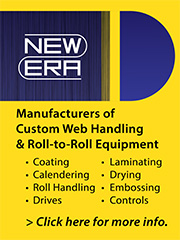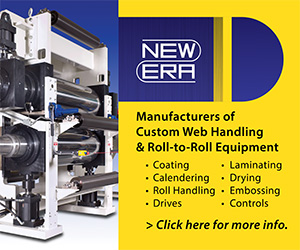Coating on Trial
- Published: May 06, 2020
By Tom Kerchiss
In coating and laminating there are many performance limiters that can affect the coating operative’s ability to produce a consistent product. But what do we mean by a consistent product? Most would say that it’s a finished product with the applied coating free from blemishes, of uniform thickness, free from coating viscosity issues – the thickness or resistance of flow and which is free from problems associated with C.O.F or co-efficient of friction: that is the slipperiness or skid resistance properties of the coating and how it interacts with the substrate.
Ideally all elements of the machine must function in unison in order to minimize process transients that may occur in a fast-moving web. For instance, process variables such as axial dimensional stability, coating thickness, lamination quality and the quality of wind up of the finished roll is dependent to a large extent on the accuracy of tension (closed loop tension control procedures and taper tension) and other web control mechanisms.
In applications that involve a drying tunnel, fluctuations in temperature and web cooling over chill rolls will affect the web at selected points in the process. Differences in the film such as gauge band variations will affect the thickness of the coating; differences associated with stock, like SSB board, which is very absorptive or foil, which is non-absorptive can also influence drying performance and must be allowed for.
Substrate properties can be critical in determining the effectiveness and quality of coating appearance and performance. It is difficult to compensate for a substrate that is defective, defects are rarely eliminated or improved by coating, drying or by the addition of other value-added enhancements. So, what should we expect from our substrates in an ideal world? To begin with substrates must have good planarity and not curl, otherwise damage will occur at the coating applicator or in the dryer. Problems can also arise when the web travels over rollers, or for laminating, when the film enters a nip or at the marrying together of separate webs. Substrates should have straight sides and be free from telescoping.
The inability to coat uniformly may sometimes arise for various reasons, one of which is that the coating solution is not evenly wetting the substrate. It may be that the surface tension of the coating and/or substrate requires modification or adjustment by flame treatment, corona treatment, etc. If the problem is directly related to the coating formula, a formulation chemist may undertake the necessary modification taking into account the surface dyne of the substrate.
While many aspects of processing can be resolved or controlled through experience some, such as airborne contamination or particulate contamination on the base film can be a major source of product waste, machine downtime and a finished product that often fails to pass muster. Unlike many process disturbances that affect a web at selected points, contaminants can manifest at all points throughout the process.
It is virtually impossible to prevent various contaminants from reaching a press, a coater or other web-processing machine. Not only will airborne contaminants such as dust, hair, clothing fibres and even skin settle on a fast-moving web, the substrate itself may be a contributing factor in contamination. For instance, prior to the coating operative taking and threading a roll ready to coat, the roll has been slit. During the process of slitting dust particles and fibre (angel hair) may contaminate the edges of the substrate and remain there during the winding process.
In relation to weight particles have a large surface area, making it easier for them to become attracted by electrostatic forces or they can be caught in the boundary layer of air on the substrate surface. Sometimes brushing or vacuum web cleaners are used in an attempt to remove contaminants. With brushes there is a risk of scratching the substrate surface of sensitive materials; vacuum web cleaners may not always be effective in breaking through the boundary layer of air created by a fast-moving web, contact web cleaners can be effective. One way to reduce the problem of contaminants is to practice good housekeeping, for instance by keeping rolls wrapped until they are ready to be mounted and by controlling as far as possible the environmental workplace. Cleanliness of all coating applicator components and of various modules and processing zones, i.e., unwind, intermediate and rewind zones is important.
Staying with the issue of environmental compliance or control: RK Print Coat Instruments VCML-Lab/Pilot coater and the pilot and production coater, the VCM can be configured for clean room conditions. The VCML-Lab/Pilot coater as an optional extra can also be equipped with an ATEX coating zone. What is ATEX compliance? Essentially ATEX or ‘Atmospheres Explosibles’ are a set of EU regulations that govern safety, particularly where ignitable concentrations of flammable gases, vapor or liquids are present continuously or for long periods of time. The ATEX regulations are comprised of areas, classes and divisions, the complexity of which warrants careful attention.
The coating solution is important, mixing time and temperature profiles must be right. The correct raw material components must be added at levels pre-determined with solution/dispersion properties, pH, particle sizes, purity and additives within proven parameters. The other elements that takes us direct to coating itself is the selection of the most suitable coating applicator technology, which may or not be obvious, especially when undertaking R & D, when engaged in contract coating or when asked to print, coat or laminate onto an unfamiliar substrate.
The converter, the coating operative, the contract coating and product developer has many types of coating systems to choose from, the options include extrusion coating; kiss coating; reverse roll, direct/reverse and offset gravure, knife over roll and slot die. There is no shortage of coating options, each has its merits and a decision to employ one technique over another depends upon economics, desired level of quality and the practicalities, whether the substrates limits or restricts the choice of coating applicator technology. The type of product being produced influences coating material choice, the adhesive and substrate.
If under normal conditions the decision to opt for one coating method over another was complicated enough, decision making has become harder still as product owners, packaging and other technologists look to materials and consumables that are not derived from petroleum-based substances, material components that are more environmentally friendly. No easy task, given the media attention, consumer concern and pressure from governments and action groups, coupled with an uncomfortable awareness that time may be running out.
Research and development have been ramped up with interest and some concrete results obtained in areas such as biopolymer materials derived from polysaccharides, proteins, lipids or a combination of material formulae that may address some of recyclable and compostable issues. Materials that are available and which share the same performance properties typically associated with conventional petroleum-based products are bio-PE and bio-PET for bottled soft drinks/water.
The question for may converters, packaging technologists with the introduction of new materials is will it process? Whether the material is PLA or polylactic acid or another material or combination of materials they have to be trialled, tested and evaluated with systems such as pilot coaters playing an integral role.
The VCML-Lab/Pilot coater can print, coat and laminate on all types of flexible substrates and on a reel-to-reel basis, The versatility of the system allows product developers and converters engaged in trialling or determining product feasibility and commercial viability to use a variety of print, laminate and coating technologies including flexography, offset gravure, meter bar, reverse roll and slot die. The VCML-Lab/Pilot coater can also be used for small-scale production so that products, processes, different methods of coating, drying/curing can be assessed under real world operating conditions.
Touch screen controlled and with a web width of 300mm the VCML-Lab Pilot coater can be custom configured to incorporate best available support ancillaries such as corona treater, edge guide, heated laminator, hot air drying/infrared and UV curing and, as mentioned earlier ATEX coating zone.







